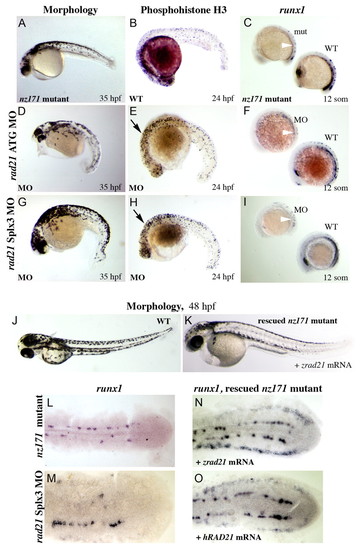
Morpholino knockdown of the rad21 gene phenocopies the nz171 mutation, both of which are rescued by injection of rad21 mRNA. (A-I) rad21 morphants phenocopy the nz171 mutation. (D,G) Embryos injected with antisense morpholino oligonucleotides targeting the start codon (rad21 ATG MO; D) and 5' donor site of exon 3 (rad21 Splx3 MO; G) physically resemble nz171 mutants (example in A) at 35 h.p.f. (B,E,H) pH3-labeled cells in rad21 morphants (E,H) compared with wild type (B). Morphants exhibit increased numbers of cells in M phase (black arrows). (C,F,I) runx1 expression in nz171 mutant (C) and rad21 morphant embryos (F,I), shown alongside wild type (WT, wild type; mut, nz171 mutant; MO, morphant). Reduced PLM runx1 expression is indicated by white arrowheads. All views lateral, anterior to the left. (J-O) The nz171 mutant phenotype is rescued by injection of a rad21 mRNA. (J,K) The morphology of nz171 mutants approaches wild type in rad21-injected embryos. (L-O) Expression of runx1 in the PLM of flat-mounted 10-somite embryos, anterior to the left, dorsal views. runx1 expression is absent from the PLM in nz171 (L) and virtually absent in a rad21 morphant (M). runx1 expression is rescued in the PLM after injection with zebrafish (N) or human (O) rad21 mRNA. See Fig. 5, Fig. 6A for wild-type expression of runx1.
|

